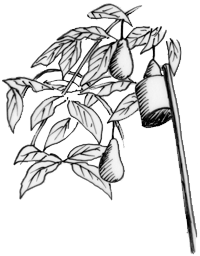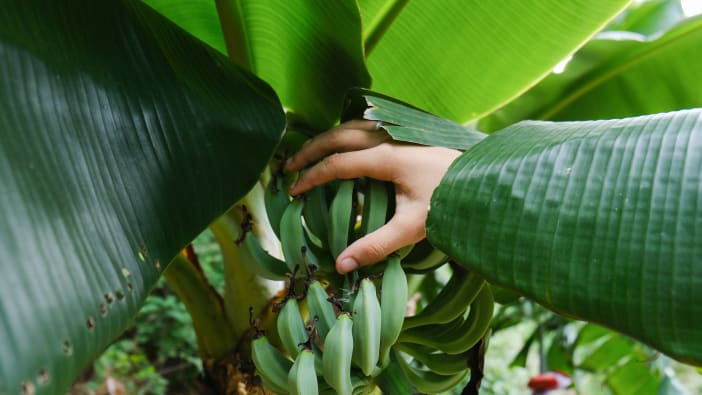Good quality dried apricots are very popular and there may be opportunities for exporting them to other countries.
These techniques can be used with other, larger fruit such as mangoes, pineapples and papaya which all need to be sliced before treating with preservative. Preservatives are not essential but they help to keep a good colour and enable the fruit to be stored a lot longer.
Adapted from an ITDG Technical brief
Chutneys
Savoury chutneys can be made from all kinds of fruit and vegetables. These are really good as relishes with meals. Unlike jams, it is often better to use fruit that is not fully ripe. Here is one recipe to try. You could also try using green tomatoes, unripe mangoes or pumpkins instead of papaya.
Papaya chutney
- 6 cups finely chopped semi-ripe papaya without skin
- 1 cup chopped onion
- 3 cloves chopped garlic
- 1⁄2 cup thinly sliced ginger
- 3 cups sugar
- 1 cup water
- 1⁄2 cup vinegar
- 1 teaspoon citric acid (optional)
- 2 teaspoons lime juice
- 1–2 teaspoons chilli powder
- 1 teaspoon salt
- 3 teaspoons cinnamon, nutmeg or mixed spice
METHOD
Cook the papaya, onion, garlic and ginger in the water for a few minutes. Add all the other ingredients. Boil gently for a further 15 to 20 minutes. Pour into glass bottles with lids. Wrap a damp cloth around the jar while pouring in the hot chutney to prevent cracking. The chutney can be kept for two or three years and the flavour will improve with keeping.
Making jams
Many fruits make excellent jams. Recipes differ but the method is always similar. The fruit used should be ripe, clean and chopped into small pieces, with skin or stones removed. The fruit is boiled gently in water until it forms a soft pulp. Sugar and other ingredients are then added and the jam is boiled fast for 5 to 20 minutes. Be very careful to prevent splashes as these will burn the skin.
Test for setting by placing a small spoonful on a clean plate. Allow to cool for two to three minutes. Push with a fingertip to see if it forms a skin and wrinkles. When the jam does this, it is ready. Pour into clean jam jars, wrapping them in a damp cloth first to prevent the jars cracking. Immediately fit a lid or tight cover. Well set jam will keep for one or two years.
Banana and papaya jam
- 3 cups ripe papaya
- 3 cups ripe banana
- 6 cups sugar
- 2 teaspoons lime juice or 1 teaspoon citric acid
- 1⁄2 cup water
Pineapple jam
- 5 cups ripe pineapple chopped into small pieces
- 3 cups sugar
- 2 teaspoons lime juice or 1 teaspoon citric acid
- 1⁄2 cup water
Mango jam
- 4 cups ripe mango (remove skin and cut into small pieces)
- 3 cups sugar
- 1 teaspoon cinnamon or mixed spice (optional)
- 2 teaspoons lime juice or 1 teaspoon citric acid
- 1 cup water
- Guava jam
- 6 cups chopped ripe guava
- 6 cups sugar
- 2 teaspoons lime juice or 1 teaspoon citric acid
- 1⁄2 cup water
Introducing squashes
People will often spend money on commercial sodas. However, these are very expensive and have few nutritional benefits. For the same price as one small bottle of soda, try making these simple fruit squashes, full of vitamins, that will provide a family with delicious drinks for several weeks.
Passion fruit squash
- 2 cups passion fruit flesh with seeds
- 6 cups sugar
- 2 cups water
- 2 teaspoons lime juice or 1 teaspoon citric acid
METHOD
Dissolve the sugar in the water. Heat gently and add the passion fruit. Bring to the boil for two minutes and then remove from heat. Add the citric acid. Cool and pour into bottles, using a fine sieve to remove the seeds. Store the juice in clean, airtight bottles. To drink, dilute with plenty of safe water.
Orange and lemon squash
- 3 oranges and 2 lemons
- 5 cups sugar
- 5 cups water
- 4 teaspoons lime juice or 2 teaspoons citric acid
METHOD
Wash fruit and peel off the outer skin using a sharp knife so that the bitter white pith remains on the fruit. Place peel and water in a pan and boil for four minutes. Add the sugar and citric acid and stir to dissolve. Halve the fruit and squeeze out the juice and add to the cooling pan. Cover and leave overnight. Strain into clean, airtight bottles. To drink, dilute with safe water. If possible, use the sweet peel for cakes or puddings.
Lime squash
- 3 cups lime juice
- 6 cups sugar
- 3 cups water
- 1 teaspoon citric acid (optional)
METHOD
Wash the fruit and cut it in half. Squeeze out the juice by hand or with a lemon squeezer, removing the seeds. Place the juice and water in a pan and bring almost to the boil. Add sugar and preservative and boil for just two minutes. Pour the hot squash into clean, airtight bottles.
Lemons can also be preserved in this way but the squash will not keep as long as lime squash.
Preservatives
For household production, when food is to be used soon, there is no need to use preservatives. However, for small businesses, the use of preservatives can help food to stay fresh longer.
Several preservatives can be used with fruit. Sodium metabisulphite is often used for small-scale food processing. This prevents or reduces the browning of fruits and vegetables. A typical concentration for treating fruit and vegetables would be 6g of sodium metabisulphite dissolved in 10 litres of water. However, in some countries its use is restricted.
Citric acid is a popular, cheap and safe preservative. It is used to preserve fruit juices and jams. It also helps to control browning of fruit and vegetables.
Sodium benzoate is used as a preservative in fruit juice, drinks, jellies, and pickles.











